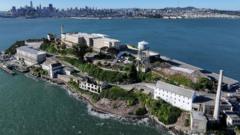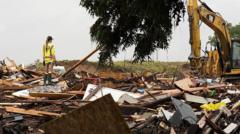**In an ambitious move, President Donald Trump suggests reopening Alcatraz, though experts doubt the feasibility due to logistical and structural concerns.**
### Trump's Alcatraz Reopening Plan: Viable or Fictional Dream?

### Trump's Alcatraz Reopening Plan: Viable or Fictional Dream?
**Explore the challenges behind the controversial proposal to revive the infamous prison island.**
In a recent statement that has sparked widespread debate, President Donald Trump reaffirmed his intentions to revive the infamous Alcatraz prison, a historical site now functioning as a tourist attraction. According to Trump, the revitalized facility could house dangerous criminals and symbolize a new era of law and order in the United States. However, prison reform advocates and historians are quick to highlight the unrealistic nature of refurbishing the decaying structures that once housed notorious criminals such as Al Capone.
Originally built as a military fortress and later transformed into a maximum-security prison in 1934, Alcatraz gained notoriety for its inescapability and high-profile inmate roster. It was shut down in 1963 due to exorbitant running costs, which were nearly three times higher than other federal prisons. Today, it attracts over 1.4 million tourists each year, thanks to its depiction in films and its rich historical significance.
Trump first revealed his vision for Alcatraz in a Truth Social post, calling on his administration to "look into" resurrecting the prison, previously dubbed "the Rock," which he believes represents strength and order. Critics have countered that the process of reopening would be a monumental task, with expert opinions noting that the facility is "literally falling apart." Hugh Hurwitz, a former acting director of the Bureau of Prisons, dismissed the idea as having no realistic foundation, stressing that significant rebuilding would be required.
Logistical issues also plague the proposal. Alcatraz has limited access to essential utilities such as water and sewage disposal, which forced past management to dispose of waste directly into the bay—a practice unfeasible today. Furthermore, prison historians have noted that the infrastructure would require extensive upgrades to meet modern safety and operational standards, which further complicates any attempts to resurrect its use as a penitentiary.
While Trump's enthusiasm has generated attention, voices from various fields, including law enforcement and public safety, doubt that the ambitions for Alcatraz can move beyond mere rhetoric. As discussions continue, the public remains divided over whether this grand vision of reopening such an iconic yet dilapidated prison is merely an exercise in nostalgia or a viable path forward.
Originally built as a military fortress and later transformed into a maximum-security prison in 1934, Alcatraz gained notoriety for its inescapability and high-profile inmate roster. It was shut down in 1963 due to exorbitant running costs, which were nearly three times higher than other federal prisons. Today, it attracts over 1.4 million tourists each year, thanks to its depiction in films and its rich historical significance.
Trump first revealed his vision for Alcatraz in a Truth Social post, calling on his administration to "look into" resurrecting the prison, previously dubbed "the Rock," which he believes represents strength and order. Critics have countered that the process of reopening would be a monumental task, with expert opinions noting that the facility is "literally falling apart." Hugh Hurwitz, a former acting director of the Bureau of Prisons, dismissed the idea as having no realistic foundation, stressing that significant rebuilding would be required.
Logistical issues also plague the proposal. Alcatraz has limited access to essential utilities such as water and sewage disposal, which forced past management to dispose of waste directly into the bay—a practice unfeasible today. Furthermore, prison historians have noted that the infrastructure would require extensive upgrades to meet modern safety and operational standards, which further complicates any attempts to resurrect its use as a penitentiary.
While Trump's enthusiasm has generated attention, voices from various fields, including law enforcement and public safety, doubt that the ambitions for Alcatraz can move beyond mere rhetoric. As discussions continue, the public remains divided over whether this grand vision of reopening such an iconic yet dilapidated prison is merely an exercise in nostalgia or a viable path forward.





















